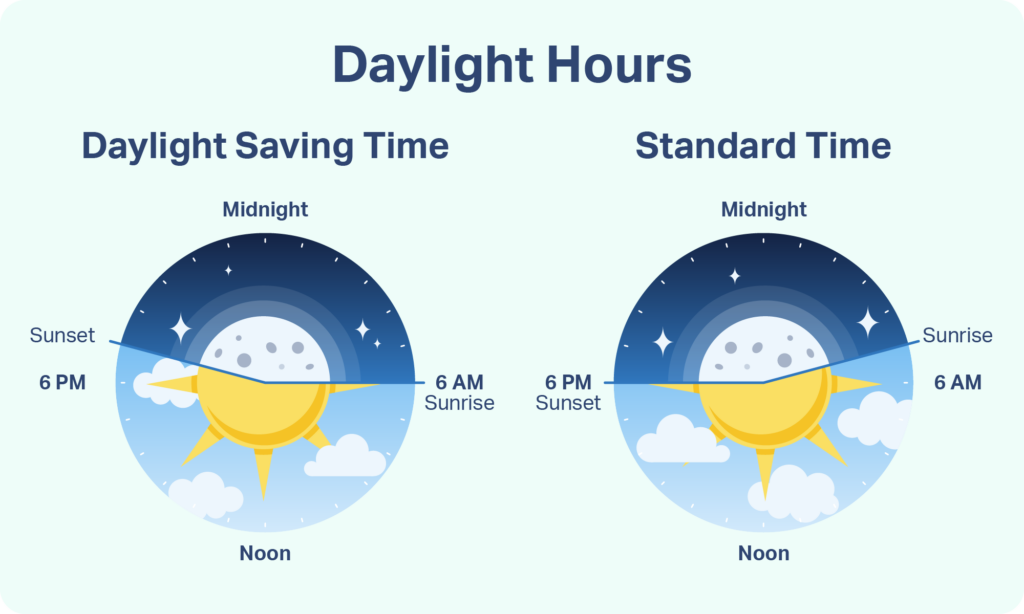Latest Updates: Daylight Saving Time in 2024

- Clocks will “spring forward” one hour at 2 a.m. local time on Sunday, March 10, 2024.
- Federal law still prohibits states from enacting permanent daylight saving time (DST).
- Proposed legislation to change federal law, such as Senator Marco Rubio’s Sunshine Protection Act, has remained stalled since gaining initial momentum in 2022.
- Dozens of states continue to consider proposals to adopt either permanent daylight saving time or permanent standard time. Yet, no states have adopted a legislative change since 2022.
- Without new movement on proposed changes, Americans should expect clock changes to continue into 2024.
Daylight Saving Time: Latest News and Policy Updates
Despite many Americans’ aversion to having to “spring forward” and “fall back” each year, all signs point to continued twice-yearly clock changes. No major legislative changes to daylight saving time (DST) were enacted recently, so clocks will spring forward on Sunday, March 10.
Federal law prohibits states from switching to permanent daylight saving time. Changes to federal law, including the Sunshine Protection Act, stalled in 2023 have yet to come up for a vote in 2024. Dozens of U.S. states are considering legislation to eliminate clock changes. But there has been relatively little momentum compared to recent years.
What Is the Sunshine Protection Act?
The Sunshine Protection Act is a bill that has been regularly introduced in the U.S. Senate by Senator Marco Rubio of Florida. Representative Vern Buchanan (R-FL) also introduced it in the House of Representatives in March 2023. The bill would establish permanent daylight saving time nationwide. Under the bill’s provisions, there would be no clock changes in the spring and fall.
The Sunshine Protection Act has yet to be presented to Congress in 2024. The versions of the bill that were introduced in 2023 remain in committee with no recent activity.
Arizona, Hawaii, and U.S. territories already following permanent standard time would be exempt from the law. These states and territories would continue using their current system of permanent standard time. Any other state that adopted permanent standard time before the Sunshine Protection Act became law would also be exempt.
The law’s effects would be most apparent from November to March when clocks would otherwise be on standard time. In general, daylight saving time means less light in the morning. So, during these months, people with typical work and school schedules would be more likely to start the day in the dark.
That said, the effects of the Sunshine Protection Act would vary by location. The amount of daylight throughout the year depends on how far a place is from the equator. In addition, cities in the western parts of each time zone have later sunrises, which can mean even less morning light under permanent daylight saving time.
Read the companion article, What Would Ending Daylight Saving Time Mean For Sleep?
What Is the Status of the Sunshine Protection Act?
So far in 2024, there has been no new movement on the Sunshine Protection Act by the U.S. Congress. The bill has not advanced since being sent to committees in the House and Senate in March 2023. To be enacted, the bills would need to win a majority vote in both the House and Senate and be signed by the president.
In March of 2022, the Sunshine Protection Act passed the Senate through an unusual process called unanimous consent. No formal vote took place, but when the bill was introduced, no senator objected to its passage. However, a companion bill in the House never made it out of committee, so the Sunshine Protection Act ran out of momentum and did not become law .
What Is the Status of State-Level Policy Changes?
Several states have considered legislation about daylight saving time in early 2024, but no new laws have been passed. This continues a trend from previous years, which involved more than two dozen states that debated but did not enact policy changes.
Various laws have been proposed, and some states even have competing legislation. Examples of proposed policy changes include:
- Enacting permanent standard time
- Enacting permanent daylight saving time contingent upon a change in federal law that permits such a policy
- Creating a statewide referendum about daylight saving time
- Commissioning a study to examine the impacts of permanent standard time or daylight saving time
Although many bills have been introduced, none have been approved. Several states in the West, including California, Washington, Oregon, and Idaho have considered laws to keep clocks consistent year-round. Frustrated by clock changes, legislators proposed adopting permanent standard time since prior efforts to use permanent daylight saving time were prohibited by federal law. None of these bills have been enacted in state legislative sessions yet.
While no new laws have gone into effect this year, a number of states have already changed their laws in prior years.
Why Hasn’t the United States Already Abolished Clock Changes?
There is no single reason that clock changes have not been abolished already. Although surveys show that clock changes are generally unpopular, there is no consensus about whether permanent standard time or permanent daylight saving time is the best alternative. With strong opinions on both sides, it can be challenging for lawmakers to win support for either approach.
In addition, changing federal law can be a drawn-out process, which has helped keep the current system in place.
What Do Experts Say About Daylight Saving Time?
Experts from different fields have weighed in on daylight saving time. While most sleep scientists prefer permanent standard time, many economists and business experts favor permanent daylight saving time.
Studies have examined the impacts of standard time and daylight saving time on things like sleep, physical and mental health, car accidents, energy consumption, crime, economic activity, and school performance.
After reviewing all of the evidence, groups of sleep experts like the American Academy of Sleep Medicine (AASM) , the Sleep Research Society , and the Society for Research on Biological Rhythms have forcefully argued that the potential harmful health effects justify a policy of permanent standard time.
In 2023, AASM formed the Coalition for Permanent Standard Time composed of various organizations and individuals. The group advocates for the adoption of permanent standard time nationwide. In 2024, AASM and the coalition reiterated their call for an end to the use of daylight saving time.
Supporting permanent daylight saving time, analysts say that more daylight in the evening could improve public safety , increase social and commercial activity, and lower electricity use.
While researchers continue to study the issue, new scientific publications have been relatively limited. Recent research appears unlikely to shift the landscape for public policy making.
What Is Public Opinion About Clock Changes and Daylight Saving Time?
Recent polls have found that over 60% of people want to end biannual clock changes. In a 2023 survey, health and safety were most commonly cited as the top priority for guiding policy decisions about clock changes.
Most polls suggest that permanent daylight saving time is more popular than permanent standard time. But experts note that poll results can vary significantly based on how the questions are phrased and when the poll is conducted.
In addition, poll results do not always align with respondents’ stated priorities. For example, a YouGov poll conducted in March 2023 showed that people strongly prefer more light in the morning. Yet, in the same survey, more people said they favored making daylight saving time permanent, resulting in less morning light and more daylight in the evening.

Why Was Daylight Saving Time Created?
The U.S. started daylight saving time in 1918 and has since implemented and repealed it various times. It was created primarily to reduce energy consumption and promote commerce. The Uniform Time Act of 1966 established the current practice of switching between standard time and daylight saving time.
Permanent daylight saving time existed during the wartime years of 1918 to 1919 and 1942 to 1945 to conserve energy. The U.S. also experimented with permanent daylight saving time in January 1974 in the face of a mounting oil crisis. That ended in October 1974 because of public dislike of darker mornings.
How Likely Are We to Stop Changing Clocks?
By most accounts, a change to the twice-yearly clock changes and enacting permanent daylight saving time at the federal level is unlikely anytime soon. Although the issue has attracted more attention and congressional support in recent years, there is still considerable disagreement about policy changes that, for the time being, will be difficult to overcome.
Daylight Saving Time Prior Updates:
Nov. 2023
On November 2, 2023, AASM announced the formation of the Coalition for Permanent Standard Time composed of various organizations and individuals who support the elimination of daylight saving time. The coalition advocates for the adoption of permanent standard time throughout the U.S. through efforts at state and national levels.
On November 15, 2023, members of the coalition traveled to the nation’s capital to express their support for legislation that would make standard time permanent nationwide. During a briefing for Congress, medical and science experts provided evidence showing the negative health impacts of the twice-yearly clock changes and the time shift to daylight saving time.
Source: The Coalition for Permanent Standard Time. Coalition Takes Standard Time Message to Capitol Hill. (January 18, 2024) Retrieved February 28, 2024 from https://ditchdst.com/2024/01/18/coalition-takes-standard-time-message-to-capitol-hill/
May 9, 2023
Two months into daylight saving time 2023, there has been no significant action on the Senate or House bills to make daylight saving time effective year-round. As it stands, daylight saving time will end on Nov. 5, 2023.
But a new study says that the November time change may be the one that hurts. The analysis of 30,000 Canadian adults found that in the week following the changing of clocks in the fall, people experienced the following:
- 115.2% increase in difficulty falling asleep
- 102.8% increase in excessive daytime tiredness, or hypersomnia
- 64% increase in difficulty staying asleep
- 34% increase in sleep dissatisfaction
Adults in the study also reported sleeping nine minutes less in the week following the time change, versus the week before it. Mind you, we gain one hour when we set our clocks back in November.
Sources:
Zolfaghari, S., Cyr, M., Pelletier, A., & Postuma, R. B. (2023). Effects of Season and Daylight Saving Time Shifts on Sleep Symptoms: Canadian Longitudinal Study on Aging. Neurology, 101(1), e74–e82. https://pubmed.ncbi.nlm.nih.gov/37137725/
March 2023
March 16, 2023: Legislators in some states that would move to permanent daylight saving time, if federal action allows it, are now second-guessing that move.
In Tennessee, for instance, bills in the state House and Senate call for a move to permanent standard time. States can do this, essentially opting out of daylight saving time, as Hawaii and most of Arizona already do. The Senate bill that passed out of committee this past Tuesday would “exempt” Tennessee from daylight saving time should multiple neighboring states do it, as well.
Neighboring Kentucky, however, has a bill in committee calling for a move to permanent daylight saving time. Its House passed a similar bill last year.
Tennessee passed a law in 2019, however, calling for a move to permanent daylight saving time.
Oregon, which has a similar permanent-standard bill in committee, also went the other way in 2019.
March 13, 2023: Many U.S. workers are adjusting to their first work day in daylight saving time 2023, which ends on Nov. 5. And with that comes renewed efforts to ensure we never change our clocks again.
In Texas, for example, a bill introduced March 10 would allow Texans to vote yes or no on Nov. 7 to adopt permanent daylight saving time. Even if Texans did so, the state would need federal action — such as passing of the latest Sunshine Protection Act — to make that move.
Earlier this year, the Texas state House took up a similar bill that would ask Texas voters to state their preference between permanent daylight saving time and permanent standard time. If a majority voted for permanent standard time, the state could move to that as early as Jan. 1, 2024.
Like a number of states, Texas spans two time zones, Central and Mountain. The referendum would not address this.
March 9 2023: Yes, daylight saving time started again on March 12 and ends on Nov. 5, 2023. And as the Washington Post outlined today , it’s likely to stay that way for a while, despite bills calling for an end to clock changes.
The Sunshine Protection Act and numerous states (see March 6 update below) are calling for permanent daylight saving time, while folks in the health world — including the American Academy of Sleep Medicine — want permanent standard time. Although the Sunshine Protection Act has co-sponsors on both sides of the aisle, it would need to pass through House and Senate-led committees.
The White House has not chimed in on its daylight saving time stance, but President Biden does have a record on the subject. When the United States briefly moved to permanent daylight saving time in 1974, the then-senator from Delaware voted for it.
March 6, 2023: Multiple states’ individual legislation to move to permanent daylight saving time stalled out when legislatures turned over. But the first clock change of 2023 likely will bring with it a renewed emphasis on abolishing the time change, with bills pending in states such as Iowa and Texas. Moving to permanent daylight saving time at the state level would require federal action.
March 3, 2023: The Sunshine Protection Act bills introduced on March 2, 2023, still require approval from the Senate and House, as well as the president’s signature, to become law.
The Senate bill includes co-sponsors from both parties. The logic, Rubio said in his statement, is simple: “This ritual of changing time twice a year is stupid.”
Rep. Vern Buchanan, R-Florida, introduced the House version with 13 co-sponsors, all of whom are Republicans.
March 1, 2023: Oklahoma is edging closer to becoming the latest state to support moving to permanent daylight saving time, if and when it’s possible to do so. On Feb. 28, the state Senate approved a bill that would choose a side on the clock change. The bill now moves to the state House.
The Oklahoman newspaper reported results of a March 2022 Amber Integrated poll stating that 47% of likely Oklahoma voters agreed with moving to permanent daylight saving time, with 24% favoring “no daylight saving time” and another 24% saying they’re OK with the current time-change system.
Sources:
Senate Bill 7, Oklahoma State Senate. (2023), Retrieved from https://oksenate.gov/press-releases/senate-approves-bill-lock-clock-daylight-saving-time
Casteel, C. (2022) Nearly half of Oklahoma voters favor permanent Daylight Saving Time, The Oklahoman., Retrieved from https://www.oklahoman.com/story/news/2022/04/12/poll-most-oklahoma-voters-want-stop-resetting-their-clocks/9502347002/
House File 242, General Assembly of the State of Iowa. (2023), Retrieved from https://www.legis.iowa.gov/legislation/BillBook?ba=HF242
Texas State Joint Resolution 9, Texas State Legislature. (2022), Retrieved from https://legiscan.com/TX/bill/SJR9/2023
Diamond, D. (2023) Permanent daylight saving time: The Clock is ticking in Congress, The Washington Post., Retrieved from https://www.washingtonpost.com/health/2023/03/09/daylight-saving-time-bill
AASM continues to oppose Permanent daylight saving time bill (2023) American Academy of Sleep Medicine – Association for Sleep Clinicians and Researchers., Retrieved from https://aasm.org/aasm-opposes-permanent-daylight-saving-time-bill-sunshine-protection-act/
SB 2329, Texas State Legislature. (2023), Retrieved from https://capitol.texas.gov/tlodocs/88R/billtext/pdf/SB02329I.pdf
HB 191, Texas State Legislature. (2023), Retrieved from https://capitol.texas.gov/tlodocs/88R/billtext/pdf/HB01931I.pdf
House Bill 77, Kentucky General Assembly. (2023), Retrieved from
https://apps.legislature.ky.gov/record/23rs/hb77.html
House Resolution 141, Kentucky General Assembly. (2022), Retrieved from https://apps.legislature.ky.gov/record/22rs/hr141.html
SB 1100, Tennessee General Assembly. (2019), Retrieved from https://wapp.capitol.tn.gov/apps/Billinfo/default.aspx?BillNumber=SB1100&ga=111
House Bill 3102, Oregon State Legislature. (2023), Retrieved from
https://olis.oregonlegislature.gov/liz/2023R1/Measures/Overview/HB3102
SB 320, Oregon State Legislature. (2019), Retrieved from
https://olis.oregonlegislature.gov/liz/2019R1/Measures/Overview/SB320
Feb. 21, 2023
Nebraska again advanced a bill that would put it on permanent daylight saving time, should federal law permit states to choose. The state passed a similar bill in 2022. It was then postponed.
The 2023 bill would require three of Nebraska’s six bordering states to also move to permanent daylight saving time. Thus far, Colorado and Wyoming have indicated they would move to permanent daylight saving time, given the chance. The Colorado Wyoming legislation, passed in 2020, would require three of Colorado, Idaho, Montana, Nebraska, North Dakota, South Dakota, or Utah to make a similar move for some or all of their population.
Sources:
Stoddard, M. (2023, March 25). Bill for year-round daylight saving time advances in Nebraska legislature. Omaha World-Herald., Retrieved from
https://omaha.com/news/state-and-regional/govt-and-politics/bill-for-year-round-daylight-saving-time-advances-in-nebraska-legislature/article_c2f089f2-ad8d-11ed-a0d3-ffaf123d147f.html
LB283, Nebraska State Legislature. (2021), Retrieved from
https://nebraskalegislature.gov/bills/view_bill.php?DocumentID=43578
HB22-1297, Colorado General Assembly. (2022), Retrieved from https://leg.colorado.gov/bills/hb22-1297
HB0044 – Mountain daylight time preservation. Sixty-Fifth Legislature of the State of Wyoming. (2020), Retrieved from https://www.wyoleg.gov/Legislation/2020/HB0044
Jan. 24, 2023
No action came from the Sunshine Protection Act before the U.S. House shuffled representatives and leadership following the November 2022 election. Rep. Cathy McMorris Rodgers, R-Wash., now leads the House Energy & Commerce Committee tasked with discussing the Senate bill. Prior chairman Rep. Frank Pallone, D-N.J., had remarked that he was not leaning toward permanent daylight saving time or permanent standard time — but said, “it’s time we stop changing our clocks.”
Meanwhile, with daylight saving time set to start again at 2 a.m. local time on March 12, 2023, more states have joined the fray in proposing their own time-change bills.
- Texas: On Jan. 18, democratic state Rep. Vikki Goodwin proposed a bill that would allow voters to decide how the state should handle the time change. If it passes, the decision would go to Texas voters in November.
- Virginia: Also on Jan. 18, the Virginia Senate passed a bill advocating for permanent daylight saving time in the state. Ultimately, that could not take place without federal action.
- Arkansas: In January, two bills proposing permanent daylight saving time did not pass out of the state House committee.
Sources
HJR 80, Texas State Legislature. (2023), Retrieved from https://capitol.texas.gov/BillLookup/History.aspx?LegSess=88R&Bill=HJR80
SB 1017 Time zone; Commonwealth shall observe Eastern Daylight Time year-round. Virginia State Legislature. (2023), Retrieved from https://lis.virginia.gov/cgi-bin/legp604.exe?231+sum+SB1017
House Bill 1039. State of Arkansas 94th General Assembly. (2023), Retrieved from https://www.arkleg.state.ar.us/Bills/FTPDocument?path=%2FBills%2F2023R%2FPublic%2FHB1039.pdf
House Bill 1104. State of Arkansas 94th General Assembly. (2023), Retrieved from https://www.arkleg.state.ar.us/Bills/FTPDocument?path=%2FBills%2F2023R%2FPublic%2FHB1104.pdf
Nov. 7, 2022
States that observe daylight saving time saw it end on Nov. 6, 2022. As of now, daylight saving time 2023 is set to start in the coming year, with efforts to make it permanent stalling in the House.
According to the Washington Post, House discussion on the bipartisan Senate bill — whose co-sponsors ranged from Sen. Patty Murray, D-Wash., and Sen. Dianne Feinstein, D-Calif., to Sen. Tommy Tuberville, R-Ala., and Sen. Rand Paul, R-Ky. — is waiting on the Department of Transportation to report on the effects of a permanent change. That analysis, however, is due on Dec. 31, 2023, after the Sunshine Protection Act is slated to take effect. This makes it unlikely that any action will come on daylight saving time until 2024.
Then-committee chairman Pallone told the Post: “We haven’t been able to find consensus in the House on this yet. There are a broad variety of opinions about whether to keep the status quo, to move to a permanent time, and if so, what time that should be.”
Source: Diamond, D. (2022, November 4). Clock runs out on efforts to make Daylight Saving Time Permanent. The Washington Post., Retrieved from https://www.washingtonpost.com/health/2022/11/04/permanent-daylight-saving-time/
Sept. 27, 2022
The start of autumn has brought with it renewed questions about daylight saving time. In short, nothing has changed for daylight saving time (DST) in 2022.
- Daylight saving time will end at 2 a.m local time on Nov. 6. People in states that observe it will move their clocks back one hour.
- The Sunshine Protection Act that the Senate passed in March 2022 has not made it to the U.S. House for discussion. It would require House passage and President Biden’s signature to become law.
- If the bill were to pass in the next year, as it’s written, permanent daylight saving time would take effect on Nov. 5, 2023. In other words, we would move our clocks forward again in March and keep them there. Until the bill or another like it passes, however, we’ll be sticking with clock changes twice a year.
June 28, 2022
Summer has started. But as expected, the U.S. House has not moved quickly to address the Sunshine Protection Act, which the Senate passed earlier this year. It has not made it to any subcommittee agenda in the House Committee on Energy & Commerce, which typically would face the task of discussing and reviewing the plan. Per the Senate’s bill, permanent daylight saving time would take effect on Nov. 5, 2023, if the legislation passes the House and receives the president’s signature.
May 24, 2022
Two months since the U.S. Senate passed the Sunshine Protection Act, the U.S. House has yet to start discussion on it. But that’s OK with the American Academy of Sleep Medicine, which reasserted its preference for permanent standard time this week. It joined the Society for Research on Biological Rhythms and the Society of Behavioral Sleep Medicine in a letter that urged the House to discuss the matter thoroughly before voting on the best option for daylight saving time moving forward.
“Standard time is a better option than daylight saving time for our health, mood, and well-being,” says Dr. Raman Malhotra, the academy’s president, in a statement. “By aligning our clock time more closely with the timing of the sun, standard time helps synchronize our bodies with our natural environment, which is optimal for our daytime functioning and nighttime sleep.”
April 13, 2022
Americans may prefer a move to permanent daylight saving time, according to a new CBS News/You Gov poll . Survey results show that 46% of participants opted for daylight saving all year long, with 33% preferring permanent standard time and 21% stating they like our current time-change setup. This preference is consistent across all demographics and political groups and included a sample group of more than 1,600 adult Americans. A separate survey of likely Oklahoma voters showed similar results .
Sleep experts and groups such as the American Academy of Sleep Medicine have come out in favor of permanent standard time. Supporters of permanent daylight saving time include University of Washington law professor Steve Calandrillo, who says the issue goes beyond sleep.
“I care about all costs and all benefits — economic, health, safety, energy. But in my opinion, the public-safety and crime-reduction positives outweigh the negatives,” Calandrillo says. “The negatives, like the winter-morning darkness impacts on school children, can be mitigated through later school start times.”
Sources
Pinto, J. D. (2023, March 8). More Americans prefer daylight saving time to Standard Time – CBS News poll. CBS News., Retrieved from https://www.cbsnews.com/news/more-americans-prefer-daylight-savings-to-standard-time-cbs-news-poll/
Casteel, C. (2022, April 12). Nearly half of Oklahoma voters favor permanent Daylight Saving Time. The Oklahoman., Retrieved from https://www.oklahoman.com/story/news/2022/04/12/poll-most-oklahoma-voters-want-stop-resetting-their-clocks/9502347002/
Got a hot tip? Pitch us your story idea, share your expertise with SleepFoundation.org, or let us know about your sleep experiences right here.
References
18 Sources
Reed, J. (2023, March 8). Sorry, Time-Switch foes, Twice-a-Year clock changing endures into 2023. National Conference of State Legislatures., Retrieved September 7, 2023, from
https://www.ncsl.org/state-legislatures-news/details/sorry-time-switch-foes-twice-a-year-clock-changing-endures-into-2023S.582 – Sunshine Protection Act of 2023. (n.d.)., Retrieved September 7, 2023, from
https://www.congress.gov/bill/118th-congress/senate-bill/582H.R.1279 – Sunshine Protection Act of 2023. (n.d.)., Retrieved September 7, 2023, from
https://www.congress.gov/bill/118th-congress/house-bill/1279Sunshine Protection Act of 2023 – Senator Marco Rubio. (n.d.)., Retrieved September 7, 2023, from
https://www.rubio.senate.gov/wp-content/uploads/_cache/files/975e79d9-7f21-4a56-8de0-244c5405a4b0/9F51AC78E0AD0C84BB5D311ED167627F.sunshine-protect-act-5.pdfBink, A. (2024, January 24). Daylight saving time: How long until the clocks change, and could it be the last time? The Hill., Retrieved February 29, 2024, from
https://thehill.com/homenews/nexstar_media_wire/4428938-daylight-saving-time-how-long-until-the-clocks-change-and-could-it-be-the-last-time/Bink, A. (2023a, March 2). Bill to make daylight saving time permanent reintroduced in Congress. The Hill., Retrieved September 7, 2023, from
https://thehill.com/homenews/nexstar_media_wire/3880009-bill-to-make-daylight-saving-time-permanent-reintroduced-in-congress/Moses, C. (2024, February 21). Oregon tries and fails to eliminate daylight saving time, for now. New York Times., Retrieved February 29, 2004, from
https://www.nytimes.com/2024/02/21/us/oregon-daylight-saving-time.htmlDaylight Saving Time | State Legislation. (2023, September 22). National Conference of State Legislatures., Retrieved February 29, 2024, from
https://www.ncsl.org/transportation/daylight-saving-time-state-legislationLugo, D. (2024, February 8). West coast states introduce legislation to make pacific standard time permanent. Salem Statesman Journal., Retrieved February 29, 2024, from
https://eu.statesmanjournal.com/story/news/politics/2024/02/08/west-coast-california-idaho-oregon-washington-introduce-bills-for-permanent-pacific-standard-time/72499335007/Rishi, M. A., Ahmed, O., Barrantes Perez, J. H., Berneking, M., Dombrowsky, J., Flynn-Evans, E. E., Santiago, V., Sullivan, S. S., Upender, R., Yuen, K., Abbasi-Feinberg, F., Aurora, R. N., Carden, K. A., Kirsch, D. B., Kristo, D. A., Malhotra, R. K., Martin, J. L., Olson, E. J., Ramar, K., Rosen, C. L., … Gurubhagavatula, I. (2020). Daylight saving time: an American Academy of Sleep Medicine position statement. Journal of clinical sleep medicine : JCSM : official publication of the American Academy of Sleep Medicine, 16(10), 1781–1784.
https://pubmed.ncbi.nlm.nih.gov/32844740/Malow B. A. (2022). It is time to abolish the clock change and adopt permanent standard time in the United States: a Sleep Research Society position statement. Sleep, 45(12), zsac236.
https://academic.oup.com/sleep/article/45/12/zsac236/6717940Roenneberg, T., Wirz-Justice, A., Skene, D. J., Ancoli-Israel, S., Wright, K. P., Dijk, D. J., Zee, P., Gorman, M. R., Winnebeck, E. C., & Klerman, E. B. (2019). Why should we abolish daylight saving time?. Journal of biological rhythms, 34(3), 227–230.
https://pubmed.ncbi.nlm.nih.gov/31170882/American Academy of Sleep Medicine. (2024, February 21). Sleep experts call for end of seasonal time changes ahead of ‘springing forward’., Retrieved February 29, 2024, from
https://aasm.org/sleep-experts-call-for-end-of-seasonal-time-changes-ahead-of-springing-forward/Calandrillo, S. P. (2019, September). It’s high time we made daylight saving permanent. University of Washington Magazine., Retrieved September 7, 2023, from
https://magazine.washington.edu/feature/daylight-savings-time/Few Americans Like Resetting Clocks. (2022, March 15). Monmouth University Poll Reports., Retrieved September 7, 2023, from
https://www.monmouth.edu/polling-institute/reports/monmouthpoll_us_031522/American Academy of Sleep Medicine. (2023). AASM sleep prioritization survey DST – legislation., Retrieved February 29, 2024, from
https://aasm.org/wp-content/uploads/2023/10/sleep-prioritization-survey-2023-dst-legislation.pdfYouGov Survey: Daylight Saving Time. (2023, March). YouGov., Retrieved September 7, 2023, from
https://docs.cdn.yougov.com/etwjvohrxx/Daylight_Saving_Time_Toplines_Crosstabs.pdfShammas, B. (2022, March 18). Why people hated permanent daylight saving time when the U.S. last tried it. The Washington Post., Retrieved September 7, 2023, from
https://www.washingtonpost.com/history/2022/03/18/daylight-saving-seventies-history/



































































































































